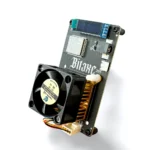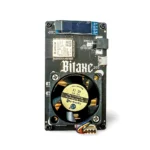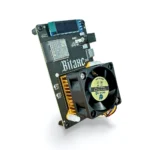What is the ROI of using Bitaxe Ultra for solo mining?
What is the ROI of Using Bitaxe Ultra for Solo Mining?
In the ever-evolving world of cryptocurrency mining, the concept of solo mining has always held a certain allure. The idea of independently solving blocks and reaping the full rewards without sharing them with a pool is enticing, but it’s often considered impractical due to the high computational power required. Enter the Bitaxe Ultra, a revolutionary ASIC Bitcoin miner that challenges this notion by making solo mining both accessible and profitable. But what exactly is the return on investment (ROI) when using the Bitaxe Ultra for solo mining? Let’s dive into the details and explore how this innovative device can transform your mining operations.
Introducing the Bitaxe Ultra: A Game-Changer in Solo Mining
The Bitaxe Ultra is not just another mining device; it’s a groundbreaking piece of technology that combines open-source architecture with cutting-edge ASIC efficiency. Designed specifically for solo mining, it empowers individuals to participate directly in the Bitcoin network without relying on centralized pools. At its core lies the BM1366 ASIC chip, delivering an impressive 500 GH/s hashrate while consuming just 15 watts of power. This performance-to-power ratio makes it one of the most efficient miners in its class, achieving approximately 33.3 GH/s per watt.

What truly sets the Bitaxe Ultra apart is its open-source design. As the world’s first open-source ASIC miner, it offers unparalleled transparency and flexibility, allowing users to verify, modify, and optimize their mining operations. This community-driven approach not only fosters trust but also ensures the device remains adaptable to future advancements in the mining ecosystem.
Key Specifications at a Glance
- Hashrate: 500 GH/s
- Power Consumption: 15 watts
- Efficiency: 33.3 GH/s per watt
- Dimensions: 10 x 6 cm
- Weight: 73g
- Cooling Options: Standard or premium Noctua fan
The Advantages of Solo Mining with Bitaxe Ultra
1. Cost-Effective Operation
One of the most significant advantages of the Bitaxe Ultra is its energy efficiency. With a power consumption of just 15 watts, it significantly reduces operational costs compared to traditional mining rigs. This efficiency translates into a lower break-even point, making it easier to achieve profitability even in competitive mining environments.
2. Direct Network Participation
By enabling users to process their own block templates, the Bitaxe Ultra promotes network sovereignty. This direct participation strengthens Bitcoin’s decentralized nature and enhances network security. Moreover, it removes the need for third-party pools, ensuring miners retain full control over their operations and rewards.
3. Compact and Scalable Design
The Bitaxe Ultra’s compact form factor makes it ideal for various deployment scenarios, from home setups to larger mining farms. Its lightweight design and advanced cooling options ensure optimal thermal management, even in densely packed environments. Additionally, its scalability allows miners to start small and expand their operations as needed.
4. Open-Source Flexibility
The open-source nature of the Bitaxe Ultra fosters innovation and customization. Users can modify the firmware to suit their specific needs, optimize performance, and stay ahead of industry trends. This adaptability ensures the device remains relevant in the fast-paced world of cryptocurrency mining.
Calculating the ROI of Bitaxe Ultra Solo Mining
To determine the ROI of using the Bitaxe Ultra for solo mining, we need to consider several factors, including initial investment, operational costs, mining rewards, and market conditions. Let’s break it down step by step.
1. Initial Investment
The Bitaxe Ultra is priced competitively, making it an affordable entry point for solo miners. While the exact cost may vary, let’s assume an initial purchase price of $1,000 for this analysis.
2. Operational Costs
With a power consumption of 15 watts, the Bitaxe Ultra operates at minimal energy costs. Assuming an electricity rate of $0.10 per kWh, the daily energy cost would be: ` 15 watts * 24 hours = 360 watt-hours = 0.36 kWh 0.36 kWh * $0.10 = $0.036 per day ` Over a year, this amounts to approximately $13.14 in electricity expenses.
3. Mining Rewards
Solo mining rewards are inherently unpredictable, as they depend on successfully solving a block. The current Bitcoin block reward is 6.25 BTC, but this is halved approximately every four years through a process known as halving.
To estimate potential earnings, we can use the concept of expected value. The probability of solving a block is proportional to your share of the total network hashrate. As of October 2023, the Bitcoin network hashrate is around 450 EH/s (exahashes per second).
With a hashrate of 500 GH/s, the Bitaxe Ultra’s share of the network hashrate is: ` 500 GH/s / 450,000,000 GH/s = 1.11e-6 (0.00000111) ` Multiplying this by the block reward gives the expected daily earnings: ` 6.25 BTC * 1.11e-6 = 0.00000694 BTC per day ` At a Bitcoin price of $30,000, this equates to approximately $0.21 per day or $76.65 per year.

4. ROI Calculation
Using the numbers above, the ROI can be calculated as follows: ` Annual Earnings: $76.65 Annual Costs: $13.14 Net Profit: $76.65 – $13.14 = $63.51 ` To recover the initial investment of $1,000, it would take: ` $1,000 / $63.51 ≈ 15.75 years ` While this may seem like a long time, it’s important to remember that solo mining is a high-risk, high-reward endeavor. Successfully solving a single block could yield a reward of 6.25 BTC, which at $30,000 would be $187,500 – far exceeding the initial investment.
5. Market Considerations
The ROI calculation is highly sensitive to Bitcoin’s price and network difficulty. A rise in Bitcoin’s value or a decrease in network difficulty could significantly improve profitability. Conversely, increased competition or a bear market could extend the break-even period.

Practical Applications and Operational Insights
The Bitaxe Ultra is not just a mining device; it’s a tool for empowering individuals to participate in the Bitcoin network on their own terms. Here are some practical scenarios where it shines:
1. Home Mining
For enthusiasts looking to dip their toes into mining without committing to expensive hardware, the Bitaxe Ultra is an excellent choice. Its low power consumption and compact design make it suitable for home setups, allowing users to mine Bitcoin while keeping energy bills in check.
2. Educational Tool
The open-source nature of the Bitaxe Ultra makes it an invaluable resource for learning about Bitcoin mining. Users can study the hardware, modify the firmware, and gain hands-on experience with ASIC technology.
3. Decentralization Advocacy
By enabling solo mining, the Bitaxe Ultra contributes to the decentralization of the Bitcoin network. It allows individuals to participate directly in the proof-of-work consensus mechanism, reducing reliance on large mining pools.
4. Customized Mining Solutions
Advanced users can leverage the Bitaxe Ultra’s open-source architecture to develop customized mining solutions. Whether it’s optimizing performance, integrating with other systems, or experimenting with new algorithms, the possibilities are endless.
Conclusion: Is the Bitaxe Ultra Worth It?
The Bitaxe Ultra represents a paradigm shift in Bitcoin mining, making solo mining accessible and meaningful. While the ROI calculation suggests a long break-even period, the potential rewards of successfully solving a block can outweigh the initial investment. Moreover, the device’s energy efficiency, compact design, and open-source flexibility offer additional benefits that extend beyond pure profitability.
Ultimately, the decision to invest in a Bitaxe Ultra depends on your goals and risk tolerance. If you’re passionate about decentralization, enjoy tinkering with technology, and are willing to embrace the uncertainties of solo mining, the Bitaxe Ultra could be a game-changer for your mining operations. It’s not just a miner; it’s a statement of independence in the world of cryptocurrency.